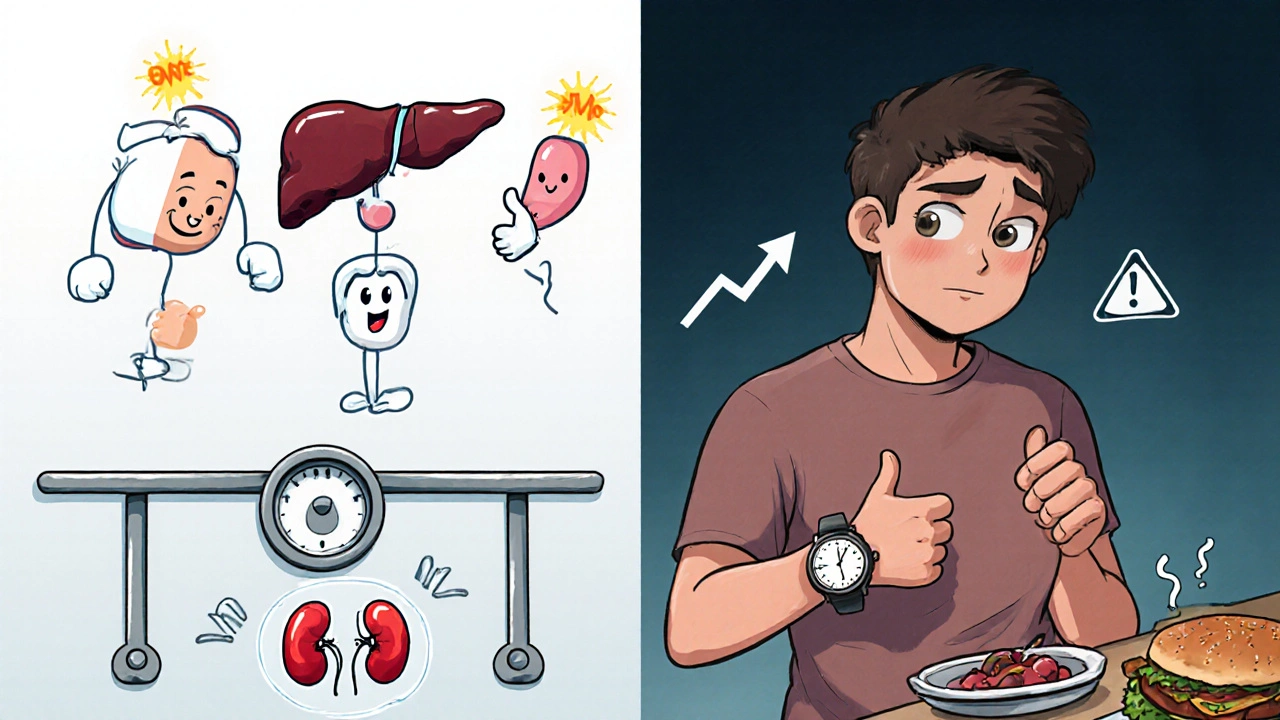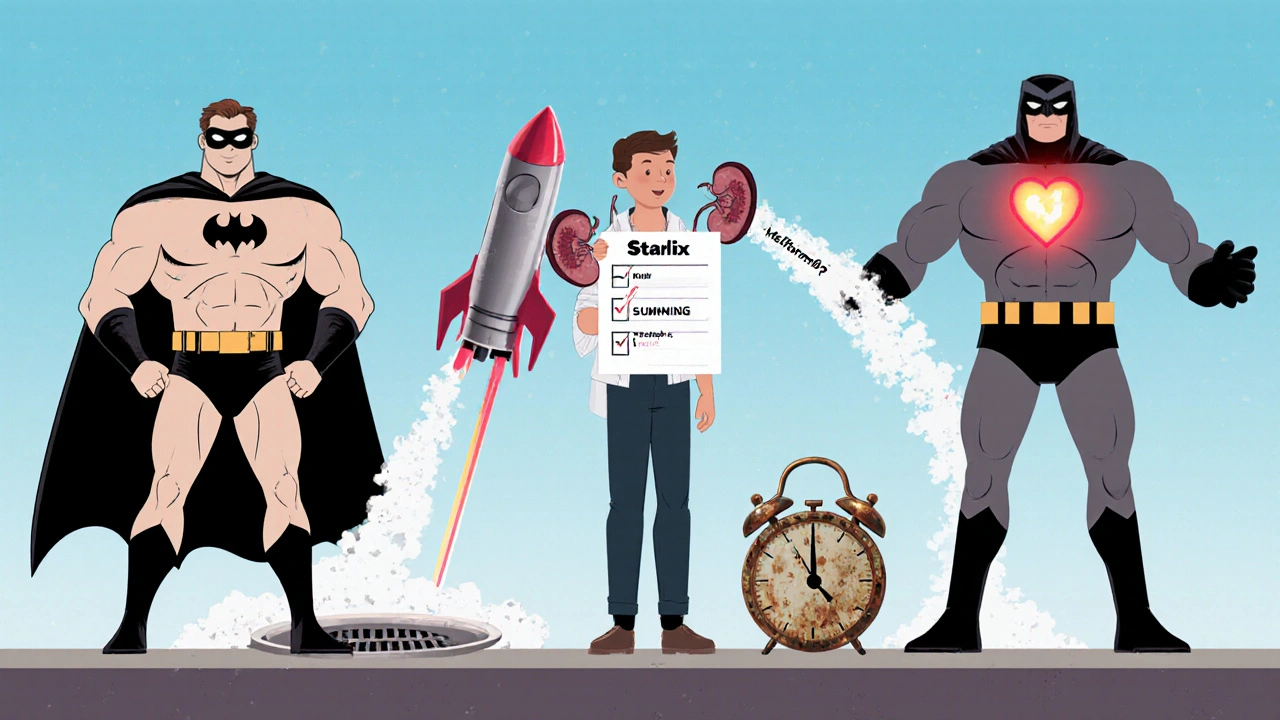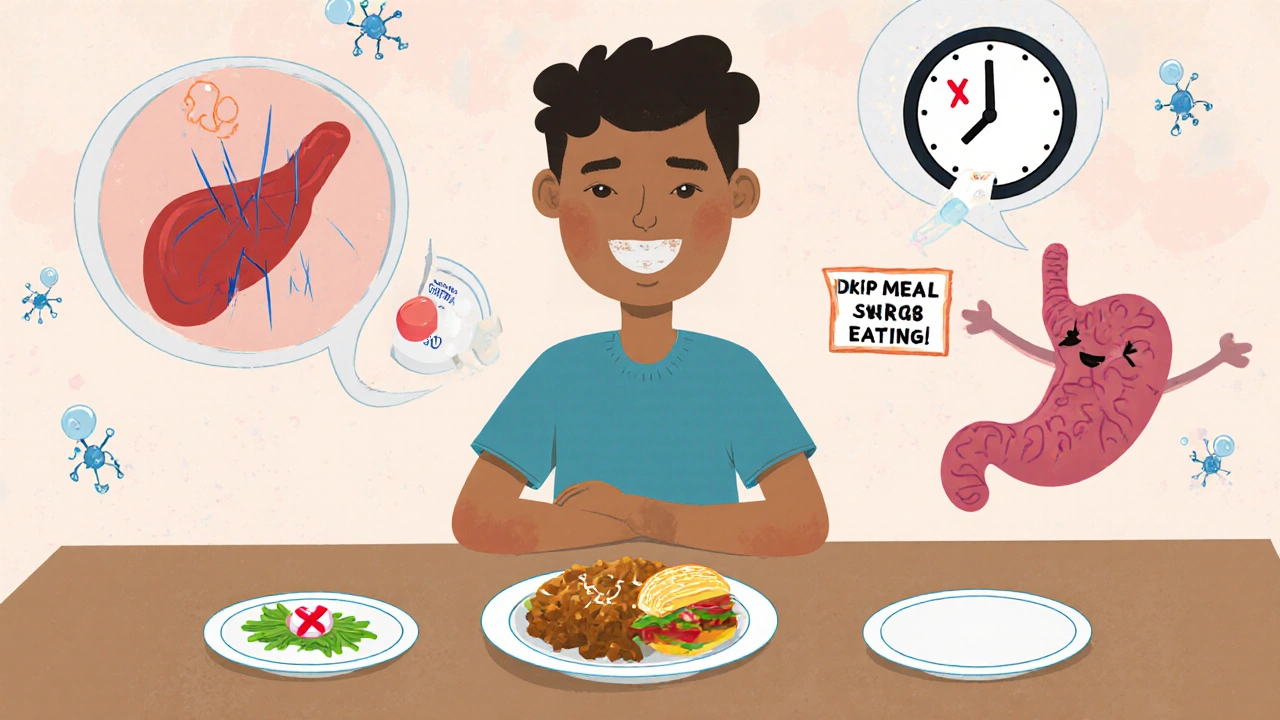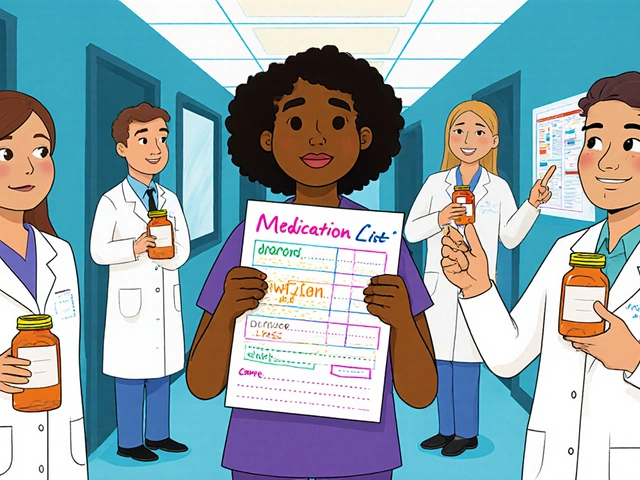If you're taking Starlix (nateglinide) for type 2 diabetes, you might be wondering if there’s a better option. Maybe your blood sugar isn’t dropping like it used to. Or maybe you’re dealing with side effects like low blood sugar or stomach upset. You’re not alone. Many people on nateglinide ask the same question: Starlix isn’t the only game in town - but is something else right for you?
What Starlix Actually Does
Starlix, or nateglinide, is a meglitinide. That’s a fancy word for a fast-acting drug that tells your pancreas to release insulin right after you eat. It’s designed to hit the spike in blood sugar that happens after meals. It’s not meant to work all day. You take it 1 to 30 minutes before each main meal. If you skip a meal, you skip the dose.
It’s not a cure. It doesn’t fix insulin resistance. It doesn’t help you lose weight. It just gives your body a quick insulin boost when food hits your stomach. That’s useful if your post-meal numbers are way too high - but it won’t help much if your fasting sugar is the real problem.
Studies show Starlix lowers HbA1c by about 0.5% to 0.8% on average. That’s modest. And it doesn’t reduce heart risk like some newer drugs do. For many people, that’s not enough.
Why People Look for Alternatives
People switch from Starlix for a few clear reasons:
- Low blood sugar (hypoglycemia) - happens in up to 15% of users, especially if meals are delayed
- It’s expensive - brand-name nateglinide can cost over £60 a month in the UK without a prescription
- It only works if you eat three solid meals a day - not great for irregular eaters
- It doesn’t help with weight loss - and some people gain weight on it
- It doesn’t protect your heart or kidneys - unlike newer options
If you’re on Starlix and still seeing HbA1c levels above 7.5%, or if you’re having frequent lows, it’s time to rethink your plan.
Metformin: The First-Line Standard
Metformin is the most common starting drug for type 2 diabetes. It’s been used for over 60 years. It works differently than Starlix: instead of pushing out insulin, it makes your liver less greedy with sugar and helps your muscles use insulin better.
Here’s how it stacks up:
- Lowers HbA1c by 1% to 2%
- Helps with weight loss - not gain
- Reduces heart attack risk by 30% in long-term studies
- Costs less than £5 a month on the NHS
- Side effects? Mostly stomach upset - which often fades after a few weeks
Metformin doesn’t cause low blood sugar on its own. That’s huge. Most people can take it safely without needing to carry sweets everywhere. If your doctor hasn’t tried metformin yet, ask why.
SGLT2 Inhibitors: The Heart-Kidney Protectors
Drugs like dapagliflozin (Forxiga) and empagliflozin (Jardiance) are newer, but they’ve changed the game. They make your kidneys flush out extra sugar through urine. Simple. Effective.
What they offer that Starlix doesn’t:
- Lower HbA1c by 0.5% to 1%
- Help you lose 2-5kg over 6 months
- Reduce heart failure hospitalisations by up to 30%
- Slow kidney disease progression - even in people with early damage
- Can be taken once daily, no meal timing needed
Side effects? You might get more yeast infections or need to pee more. But for people with heart or kidney issues, these are often the top choice now. NICE guidelines in the UK recommend them for patients with cardiovascular disease or chronic kidney disease.

GLP-1 Receptor Agonists: The Weight-Loss Powerhouses
These are injectables like semaglutide (Ozempic, Wegovy) and liraglutide (Victoza). They mimic a gut hormone that slows digestion, reduces appetite, and boosts insulin only when blood sugar is high.
Why they beat Starlix:
- HbA1c reduction: 1% to 1.8%
- Weight loss: 5% to 15% of body weight
- Heart protection: proven to cut heart attacks and strokes
- Low risk of hypoglycemia - unless mixed with insulin or sulfonylureas
Yes, they’re injectables. Yes, they cost more. But for someone struggling with weight and blood sugar, the benefits are life-changing. A 2024 UK study found that 68% of patients on semaglutide dropped their HbA1c below 7% within 6 months - and kept the weight off.
They’re not for everyone - nausea is common at first - but they’re becoming the gold standard for overweight patients with type 2 diabetes.
Sulfonylureas: The Old Workhorses
Drugs like gliclazide and glimepiride are older than Starlix. They force your pancreas to pump out insulin all day - not just after meals. That makes them more powerful but also riskier.
Compared to Starlix:
- Stronger HbA1c drop - up to 1.5%
- Longer-lasting effect - once or twice daily dosing
- Higher risk of low blood sugar - up to 25% of users
- Can cause weight gain - often 3-6kg
They’re cheap. But the risk of dangerous lows and weight gain makes them a second-line choice now. Many doctors avoid them unless other options aren’t possible.
What About DPP-4 Inhibitors?
Drugs like sitagliptin (Januvia) and linagliptin (Trajenta) are sometimes called “glipizide with fewer lows.” They boost your body’s own insulin signals without forcing them out.
Pros:
- Low risk of hypoglycemia
- No weight gain
- Once-daily pill
Cons:
- HbA1c reduction is weak - only 0.5% to 0.8%
- Expensive - often more than Starlix
- No heart or kidney benefits proven
They’re a decent option if you can’t take metformin and want to avoid lows. But they don’t offer much beyond what Starlix does - and they cost more.

Insulin: When Everything Else Fails
If your pancreas has given up, insulin is the only real fix. Many people stay on Starlix too long because they fear needles. But insulin isn’t a failure - it’s a tool.
Modern insulins like glargine (Lantus) or degludec (Tresiba) are long-acting. You take them once a day, and they keep your baseline sugar steady. You can still take Starlix with them if you need meal-time control.
Insulin lowers HbA1c by 1.5% to 2.5%. But you need to learn carb counting, check your sugar often, and watch for lows. It’s work - but it works.
Which Alternative Is Right for You?
Here’s a quick guide based on your situation:
| Your Main Goal | Best Alternative | Why It Fits |
|---|---|---|
| Lower HbA1c fast | Metformin | Strong, safe, cheap, proven |
| Need to lose weight | GLP-1 agonists (semaglutide) | Best weight loss, heart protection |
| Heart or kidney disease | SGLT2 inhibitors (dapagliflozin) | Proven to protect organs |
| Afraid of lows | Metformin or DPP-4 inhibitors | Minimal hypoglycemia risk |
| On a tight budget | Metformin or sulfonylureas | Under £10/month on NHS |
| Irregular meals | SGLT2 or GLP-1 | No need to time doses with food |
If you’re unsure, start with metformin. It’s the most studied, safest, and cheapest. If that’s not enough, add an SGLT2 inhibitor. If you’re overweight and still struggling, talk about GLP-1s. Starlix? It’s a narrow tool for a narrow problem.
What to Do Next
Don’t stop Starlix on your own. Talk to your doctor or diabetes nurse. Bring your blood sugar log - especially your post-meal numbers. Ask:
- Is my HbA1c still too high?
- Am I having low blood sugar episodes?
- Have I gained weight since starting this?
- Do I have heart or kidney issues?
- Is there a cheaper, safer option?
Most people on Starlix can do better. The diabetes landscape has changed a lot since 2010. You deserve a treatment that doesn’t just manage sugar - it protects your future.
Is Starlix still prescribed today?
Yes, but rarely as a first choice. Starlix is still used in the UK for people who can’t take metformin and have very high post-meal spikes. But most new prescriptions go to metformin, SGLT2 inhibitors, or GLP-1 agonists because they offer more benefits - especially for heart and kidney health.
Can I switch from Starlix to metformin safely?
Yes, and it’s often recommended. Your doctor will likely stop Starlix and start metformin slowly - maybe 500mg once a day, then increase over a few weeks. You won’t need to change your meal schedule. Metformin doesn’t cause lows on its own, so you won’t need to carry snacks unless you’re on other drugs.
Do any alternatives cause weight gain?
Yes. Sulfonylureas (like gliclazide) and insulin can cause weight gain - often 3-6kg. Starlix can too, though less than those. Alternatives like metformin, SGLT2 inhibitors, and GLP-1 agonists either help you lose weight or keep it stable. If weight is a concern, avoid the older insulin-stimulating drugs.
Is Starlix better than taking insulin?
No, not really. Starlix only works if your pancreas still makes some insulin. Insulin replaces what your body can’t. If your HbA1c is above 9% or you’re losing weight despite eating, your pancreas may be failing. That’s when insulin becomes necessary. Starlix won’t help you there.
How much does Starlix cost in the UK?
With an NHS prescription, Starlix is free. Without one, a 30-day supply can cost £50-£70. Generic nateglinide is cheaper abroad but not commonly imported. Most people on the NHS get it at no cost - but alternatives like metformin or dapagliflozin are just as effective and often preferred by clinicians.
Final Thought
Diabetes isn’t about one magic pill. It’s about matching the right tool to your body, your life, and your goals. Starlix was useful in its time - but today’s options do more than just lower sugar. They protect your heart, your kidneys, and your waistline. If you’re still on it, don’t feel guilty. But do ask: is this the best I can do in 2025? The answer might surprise you.







Vishnupriya Srivastava
October 28, 2025 AT 00:45Starlix is basically a band-aid for post-meal spikes. If you’re not eating three clean meals a day, it’s useless. I’ve seen patients on it for years with HbA1c stuck at 8.2% while their weight creeps up. Metformin’s the real baseline. Nothing fancy, just works.
Matt Renner
October 28, 2025 AT 13:20While the clinical comparisons presented here are accurate and well-structured, it is essential to emphasize that individual patient factors-including comorbidities, socioeconomic status, medication adherence, and psychological readiness-must inform therapeutic decisions. The algorithmic approach implied by the table may oversimplify a complex, dynamic condition. Personalized medicine remains paramount.
Ramesh Deepan
October 29, 2025 AT 16:27Look, I’ve been on Starlix for 3 years. My doc kept pushing it because I’m ‘not obese enough’ for GLP-1s. Then I switched to metformin + dapagliflozin. Lost 11kg, no more 3am crashes, HbA1c dropped to 6.1%. Starlix is a relic. If your doctor isn’t talking about heart and kidney protection, they’re stuck in 2012. Ask for the guidelines. Don’t take no for an answer.
Wayne Rendall
October 30, 2025 AT 14:57The distinction between meglitinides and sulfonylureas is accurately delineated, though the omission of pharmacokinetic half-lives-particularly the 1.5-hour half-life of nateglinide versus the 10–12-hour half-life of gliclazide-is a notable technical lacuna. Furthermore, the assertion that SGLT2 inhibitors reduce heart failure hospitalisations by up to 30% is corroborated by the EMPA-REG OUTCOME and DAPA-HF trials, which should be cited for academic rigour.
Ifeoluwa James Falola
October 31, 2025 AT 12:08Metformin first. Always. No drama. No needles. Just pills. Works. Cheap. Safe. If it doesn’t, then talk about the rest. Starlix? Not worth the hassle.
Adam Phillips
November 1, 2025 AT 07:55Starlix is just another way we try to control nature with chemicals instead of changing how we live. We eat too much sugar we get sick then we take a pill that makes our pancreas work harder like a slave. But the real question is why are we eating like this in the first place. The body isn’t broken the system is. But nobody wants to hear that
Julie Lamb
November 2, 2025 AT 15:34I switched to semaglutide last year and I’m crying happy tears 😭 I lost 22lbs, my energy is back, and I don’t feel like I’m constantly fighting my own body anymore. You’re not failing if Starlix isn’t working-you’re just ready for something better 💪❤️
april kakoske
November 3, 2025 AT 15:13Starlix made me hungry all the time like my body was begging for food even after eating. Switched to GLP-1 and now I just… don’t crave junk. It’s weird. Like my brain got an update. Also my knees don’t hurt as much now. Who knew sugar control could fix that
Pradeep Meena
November 5, 2025 AT 09:27Why are we even talking about western drugs when India has ayurvedic solutions like bitter gourd and fenugreek? Starlix is just a profit scheme by big pharma. Our ancestors managed diabetes without pills. You people are too lazy to change your diet. Just eat less rice and sugar. Problem solved. No need for expensive imports.